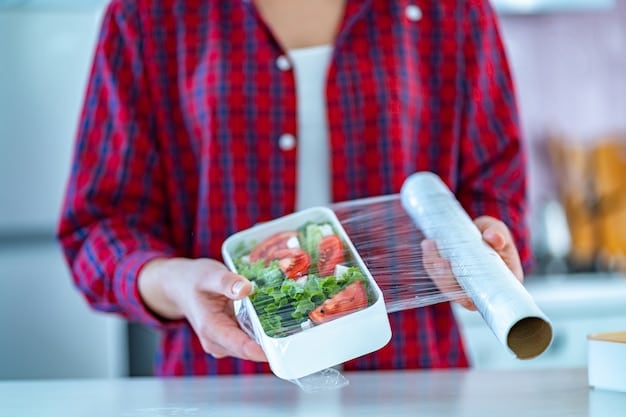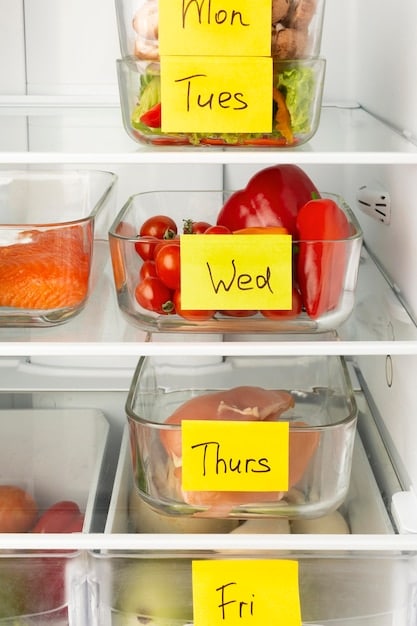Reducing Food Waste at Home: Practical Tips for Families in 2025

Reducing food waste at home is crucial; in 2025, families can adopt practical tips like meal planning, proper storage, creative cooking with leftovers, and understanding expiration dates to minimize waste and save money.
Discover actionable strategies for reducing food waste at home in 2025, empowering families to minimize their environmental impact and save money through conscious consumption habits.
Embracing a Zero-Waste Kitchen: Why It Matters
In the year 2025, the call for sustainable living resonates more profoundly than ever, making the concept of a zero-waste kitchen not just a trend but a necessity. One of the most impactful ways families can contribute to this movement is by actively reducing food waste within their homes.
Understanding why it matters is the first step toward cultivating mindful consumption habits and fostering a more sustainable lifestyle for future generations.
The Environmental Impact of Food Waste
Food waste significantly contributes to greenhouse gas emissions. When food ends up in landfills, it decomposes and releases methane, a potent greenhouse gas that accelerates climate change. Furthermore, the production of wasted food consumes vast amounts of resources, including water, land, and energy, exacerbating environmental degradation.
The Economic Benefits of Reducing Food Waste
Beyond its environmental consequences, food waste has a substantial economic impact on households. According to studies, families can save a considerable amount of money each year by minimizing food waste. By adopting simple strategies such as meal planning, smart shopping, and creative cooking, families can optimize their food budgets and reduce unnecessary expenses.
- Plan meals ahead: Create a weekly meal plan to avoid impulse purchases and ensure that ingredients are used efficiently.
- Shop with a list: Stick to your shopping list to prevent overbuying and reduce the likelihood of food spoilage.
- Store food properly: Utilize proper storage techniques to extend the shelf life of perishable items and minimize waste.
Reducing food waste at home is not only an environmentally responsible choice but also a financially savvy one. By embracing conscious consumption habits and implementing practical strategies, families can make a significant impact on both their wallets and the planet.

In conclusion, embracing a zero-waste kitchen offers numerous benefits, ranging from mitigating environmental concerns to enhancing household finances. By understanding the impact of food waste and adopting proactive measures, families can lead more sustainable and fulfilling lives in 2025 and beyond.
Mastering Meal Planning for Minimal Waste
Meal planning emerges as a cornerstone strategy for minimizing food waste and promoting conscious consumption. By taking a proactive approach to organizing meals, families can streamline grocery shopping, reduce impulse purchases, and ensure that ingredients are utilized efficiently.
Mastering the art of meal planning not only mitigates waste but also fosters creativity in the kitchen and enhances overall dietary habits.
Creating a Weekly Meal Plan
Start by setting aside time each week to plan your meals. Consider your family’s preferences, dietary needs, and any leftovers you have on hand. Develop a comprehensive meal plan that outlines breakfast, lunch, dinner, and snacks for each day of the week. Be realistic about your schedule and adjust meal choices accordingly. Once the plan is laid out and completed, compare it against the food already available to determine what is missing.
Incorporating Leftovers into Your Plan
Leftovers offer a valuable opportunity to reduce waste and create new culinary experiences. Identify ways to repurpose leftovers into exciting dishes. For example, leftover roasted chicken can be transformed into chicken salad sandwiches, while leftover vegetables can be added to soups or stir-fries. This way, no food gets thrown away, and everything is consumed.
- Designate a “leftover night”: Dedicate one night each week to consuming leftovers from previous meals.
- Get creative with repurposing: Transform leftovers into new dishes to avoid monotony and maximize utilization.
- Store leftovers properly: Use airtight containers and label leftovers with dates to ensure freshness and safety.
Mastering meal planning is an essential component of reducing food waste at home. By implementing strategic planning, incorporating leftovers, and practicing mindful shopping habits, families can minimize waste, save money, and cultivate a more sustainable lifestyle.
Therefore, incorporating meal planning into your daily life is not just about preparing meals, but also preventing food waste.
Smart Shopping Strategies: Buy Only What You Need
Smart shopping strategies play a pivotal role in minimizing food waste and promoting conscious consumption habits. By adopting mindful shopping practices, families can avoid overbuying, prevent spoilage, and ensure that every purchase serves a purpose.
The importance of smart shopping comes from how it is an effective way to prevent food from going to waste, and allows you to only buy what you need.
Creating a Detailed Shopping List
Before heading to the grocery store, take the time to create a detailed shopping list based on your meal plan. Review your pantry and refrigerator to identify what you already have on hand. Organize your shopping list by sections within the store to streamline your shopping trip and minimize impulse purchases. Comparing your list to what you already have is an important step in meal preparation and not buying too much food.
Understanding Expiration Dates and Labels
Familiarize yourself with expiration dates, “use by” dates, and “best before” dates on food products. Understand that “best before” dates indicate quality rather than safety, and many foods can still be consumed safely after this date. Use your judgment and rely on your senses to assess the freshness of food items before discarding them. This helps to decrease the amount of waste on food products.

- Plan your list based on recipes: Use meal plans effectively so you can use the ingredients from recipes.
- Buy on a set schedule: Set a specific time of week to go grocery shopping to allow less impulse buys.
- Look at expiration dates: Knowing what the expiration dates are allows you to know how much time you have to eat the food to prevent from going to waste.
Smart shopping strategies reduce the likelihood of food waste and promote conscious consumption habits. By creating detailed shopping lists, sticking to your plan, and understanding expiration dates, families can minimize waste, save money, and cultivate a more sustainable approach to food shopping.
In summary, with these tips, you can shop intentionally and consume food more efficiently.
Optimizing Food Storage for Freshness and Longevity
Optimizing food storage techniques is essential for preserving freshness, extending shelf life, and minimizing food waste. By implementing proper storage methods, families can keep food fresher for longer periods, reducing the likelihood of spoilage and waste.
Optimizing food storage allows families to consume more food as well as save money on their grocery bill overall.
Utilizing Proper Containers and Packaging
Invest in high-quality, airtight containers for storing leftovers, pre-cut vegetables, and other perishable items. Glass containers and reusable silicone bags are excellent options for minimizing plastic waste and preserving food freshness. Ensure that containers are properly sealed to prevent air exposure, which can accelerate spoilage. Storing food in these containers is vital in freshness.
Understanding Temperature and Humidity Requirements
Different foods have different storage requirements in terms of temperature and humidity. Store fruits and vegetables in separate drawers or compartments to prevent cross-contamination and optimize shelf life. Keep herbs and leafy greens fresh by storing them in the refrigerator wrapped in damp paper towels or submerged in water. Keeping these fresh for the longest time possible will allow you to have more food to eat.
- Use clear containers: Knowing what kind of food is being stored can allow you to have clarity of what to plan meals with.
- Cool food before storing: Let food cool down completely before placing in refrigerator to prevent temperature imbalances.
- Keep refrigerator clean: Regularly clean out the refrigerator to keep it working well.
Optimizing food storage techniques and practices contributes to enhancing the quality and longevity of food and minimizing waste. By utilizing proper containers, understanding temperature requirements, and regularly organizing your refrigerator and pantry, families can reduce waste, save money, and enjoy fresher, healthier meals.
In simple terms, better storage guarantees fresher produce and less waste.
Creative Cooking with Leftovers: Turning Scraps into Delights
Creative cooking with leftovers provides an innovative pathway for families to minimize food waste, reduce mealtime monotony, and explore new culinary horizons. By transforming food scraps into delicious dishes, families can unlock hidden flavors, reduce expenses, and foster sustainability in the kitchen.
Cooking with extras allows families to explore new foods, and reduce food waste by consuming all of it.
Transforming Leftovers into Exciting Dishes
Get imaginative with your leftovers and discover new ways to repurpose them into exciting dishes. Leftover roasted chicken can be shredded and tossed into tacos, salads, or pasta dishes. Leftover vegetables can be blended into soups, purees, or frittatas. Get creative with sauces, spices, and herbs to add depth and complexity to your culinary creations.
Reducing Waste through Innovative Recipes
Explore inventive recipes that utilize food scraps and often discarded ingredients. Vegetable peels and stems can be used to make flavorful broths and stocks. Stale bread can be transformed into breadcrumbs or croutons. Overripe fruits can be blended into smoothies or baked into muffins and cakes. Embrace experimentation and discover new ways to turn waste into culinary treasures.
- Learn from different cuisines: Different cuisines utilize leftovers in unique ways that can be explored.
- Make it a family activity: Getting entire family involved in cooking the leftovers allows for more variety.
- Share ideas and trade: Having a community that shares creative ideas allows everyone to have more to eat.
Creative cooking with leftovers not only reduces food waste but also enhances culinary creativity and fosters sustainability in the kitchen. By transforming food scraps into delightful dishes, families can contribute to a more sustainable food system and reduce their environmental footprint.
The goal is to transform what might seem like waste into culinary masterpieces.
Educating and Engaging the Family in Waste Reduction
Engaging the Family in Waste Reduction will allow everyone to be involved in the cause. By educating and engaging all family members in waste reduction initiatives, families can cultivate a culture of sustainability, promote conscious consumption habits, and minimize environmental impact.
Getting everyone involved will create long-term waste reduction.
Raising Awareness about Food Waste Issues
Start by educating your family about the environmental, economic, and social consequences of food waste. Share statistics, infographics, and articles that highlight the magnitude of the problem. Engage in discussions about the importance of waste reduction and its impact on the planet. Let everyone in the family be aware of what goes on and let everyone know what they can do to help.
Involving Children in Meal Planning and Shopping
Empower children to participate in meal planning and shopping activities. Involve them in creating shopping lists, selecting recipes, and choosing fresh produce. Teach them about portion control, expiration dates, and proper food storage techniques. Provide them with opportunities to make informed choices and understand the value of reducing waste. Also, take them out for grocery day so they can be involved in the process of selecting the meals. This will teach everyone and children how to portion food as well.
- Gamify food waste reduction: Turning reducing food waste into games can increase participation.
- Set realistic goals: Reduce food waste a little bit at a time will make tasks easier.
- Make it a team goal: Having everyone on board to reduce waste will improve results overall.
Educating and engaging the family in waste reduction not only promotes sustainability but also fosters collaboration and strengthens family bonds. By raising awareness, involving children, and setting achievable goals, families can create a culture of conscious consumption and minimize their environmental footprint.
Everyone involved allows waste reduction to be more effective and for the whole team to improve.
| Key Point | Brief Description |
|---|---|
| 🌱 Meal Planning | Plan meals weekly to buy only what’s needed and reduce waste. |
| 🛒 Smart Shopping | Shop with a detailed list and understand expiration dates. |
| 📦 Food Storage | Use proper containers/temps to maximize freshness. |
| 👨👩👧👦 Family Involvement | Involve family in planning, reduces waste together. |
FAQs
Meal planning helps reduce waste by ensuring you only buy ingredients you need for planned meals, preventing impulse purchases and overstocking your fridge and pantry.
Store produce in proper conditions. Some fruits and vegetables should be refrigerated while others stay fresh longer outside. Use airtight containers or bags to maintain humidity and prevent spoilage.
Get creative by repurposing leftovers. Roast chicken can become tacos or salad toppings. Cooked vegetables can be blended into soups. Think of new ways to combine available foods.
“Best Before” indicates quality, not safety. Consuming food past this date is okay. “Use By” dates are for safety; consume before to avoid risk. Always inspect and use judgment.
Involve family members in planning meals, shopping, and cooking. Teach them about food waste issues and proper storage techniques. Make it a team effort with clear goals.
Conclusion
Reducing food waste at home in 2025 encompasses more than just individual actions; it represents a collective commitment towards sustainability and mindful consumption. By embracing the simple yet impactful tips outlined in the content above, families can not only diminish their ecological impact but also savor the advantages of resourceful living.





